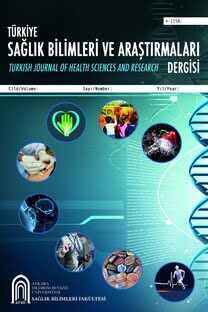Kabuki Make-Up Sendromlu Hastada Genel Anestezi Uygulaması
Amaç: Kabuki make-up sendromu otozomal dominant kalıtılır, %25 olguda mutasyon saptanmayabilir. Sendrom başta kardiyovasküler, iskelet sistemi olmak üzere pek çok sistemi ilgilendiren malformasyonlarla anesteziyi komplike hale getirmektedir Yenidoğan döneminde diyafragma hernisi tesbit edilmiş, eklem laksisitesi nedeni ile opere edilmiş, sol gözde pitozisin eşlik ettiği tipik yüz görünümlü hastamızda minimal mental retardasyon mevcuttu. KMS’li hastamızda anestezi deneyimimizi paylaşmayı amaçladık.Yöntem: Ankiste hidrosel, fimozis nedeniyle başvuran 6 yaşındaki Kabuki make-up sendromlu hastamızda cerrahi süreci başarılı premedikasyon, genel anestezi uygulaması ile komplikasyonsuz olarak tamamladıkBulgular: Olgumuzda kas gevşeticisiz ve endotrakeal entübasyon uygulamadan, laringeal maske kullanarak, narkotik destekli inhalasyon anestezisi ile genel anestezi uyguladık. Sonuç: Bu hastalarda görülme riski yüksek üst solunum yolu obstrüksiyonu, entübasyon zorluğu, malign hipertermi riskleri göz önünde bulundurularak zor entübasyon ekipmanları, acil ilaç desteği hazır olmalıdır. Hastaların küçük yaşta olması, mükerrer anestezi alabileceği göz önünde bulundurularak iyi premedikasyon, postoperatif analjezi sağlanarak olumlu anestezi deneyimi ile hastaneden ayrılmaları sağlanmalıdır
Anahtar Kelimeler:
anestezi, hidrosel, Kabuki Make-up sendromu
General anesthesia experience in a patient with Kabuki Make-Up syndrome
Aim: Kabuki Make-up Syndrome is inherited in an autosomal dominant manner and no mutation can be detected in 25% of cases. The syndrome complicates anesthesia with malformations involving many systems, especially the cardiovascular and skeletal systems. There was minimal mental retardation in our patient, who was diagnosed with diaphragmatic hernia in the neonatal period, had a typical facial appearance accompanied by ptosis in the left eye, and was operated for joint laxity. In our case, we aimed tos hare our anesthesia experience in our patient with Kabuki make-up syndrome.Method: In our 6-year-old patient with Kabuki make-up syndrome, who was admitted due to anxisted hydrocele and phimosis, we completed the surgical procedure without complications with succesful premedication and general anethesia.Results: In our case, we applied general anesthesia with narcotic-assisted inhalation anesthesia using alaryngeal mask without muscle relaxants and endotracheal intubation. Conclusion: Considering the high risk of upper airway obstruction, intubation difficulty and malign hyperthermia risks in these patients, diffucult intubation equipment and energency drug support should be ready. Considering the young age of patients and the possibility of repeated anesthesia, good premedication and postoperative analgesia should be provided and they should leave the hospital with a positive anesthesia experience.
___
- KAYNAKLAR 1. Kuroki Y, Suzuki Y, Chyo H, Hata A, Matsui I. A new malformation syndrome of long palpebral fissures, large ears, depressed nasal tip, and skeletal anomalies associated with postnatal dwarfism and mental retardation. J Pediatr 1981;99:570–3.
- 2. Niikawa N, Matsuura N, Fukushima Y, Ohsawa T, Kajii T. Kabuki make-up syndrome: a syndrome of mental retardation, unusual facies, large and protruding ears, and postnatal growth deficiency. J Pediatr 1981;99:565–9. [CrossRef]
- 3. Matsumoto N, Niikawa N. Kabuki make-up syndrome: a review. Am J Med Genet C Semin Med Genet 2003;117C:57–6
- 4- Türe E, Yazar A, Akın F, Zaimoğlu A G, Odabaş D. Nadir Bir Olgu: Kabuki Make-Up Sendromu Haydarpasa Numune Med J 2017;57(3):183–185 DOI: 10.14744/hnhj.2017.74745
- 5- Linlea A, Abd El Moneim A, Aleck K et al. Further delineation of Kabuki syndrome in 48 well-defined new individuals. Am J Med Genet 2005; 132:265-272.
- 6. Vaccaro M, Salpietro DC, Briuglia S, Merlino MV, Guarneri F, Dallapiccola B. Cutis laxa in Kabuki make-up syndrome. J Am Acad Dermatol 2005; 53:247-251.
- 7- Ünalp A, Giray Ö. Kabukı-Make-Up Syndrome: A Case Report DEÜ Tıp Fakültesi Dergisi Cilt 22, Sayı 1, (Nisan) 2008, S: 23-26
- 8. Sert A, Atabek M E, Pirgon Ö. Two New Kabukı Cases Of Kabukı Make-Up Syndrome . Marmara Medical Journal 2006;19(2);86-89
- 9- Yücel T, Şalvız E A, Sarıarslan D, Ter M, Aksoy R. An Anesthesıa Experıence Of A Pedıatrıc Patıent Wıth Kabukı Syndrome. Journal of Anesthesia 2011; 19 (3): 182 - 186
- 10- Hannibal M C, Buckingham KJ, Ng S B, et al . Spectrum Of MLL2 (ALR) Mutations İn 110 Cases Of Kabuki Syndrome. Am J Med Genet A 2011;155A:1511–6. (CrossRef)
- 11. Miyake N, Mizuno S, Okamoto N, et al. KDM6A Point Mutations Cause Kabuki Syndrome. Hum Mutat 2013;34:108–10. (CrossRef)
- 12- Erginel A, Tüysüz B, Kartal A, Elçioğlu N, Cenani A. Bir Türk çocuğunda Kabuki make-up (Niikawa- Kuroki) sendromu. İst Çocuk Klin Derg 1994;29:66-70. (CrossRef)
- 13- Roy D, Das T, Ahmed A, Rudra A, Mitra D. Kabuki Syndrome And İts Anaesthetic Management. Indian Journal of Anaesthesia.Vol 55, Issue 4 ,Jul-Aug 2011. PMID: 22013278
- 14. Erden İ A, Köseoğlu A, Kürkçüoğlu B S, Akıncı S B, Aypar Ü. The Anesthetic Management İn The Patient With Kabuki Makeup Syndrome Case Report. Journal of Clinical and Experimental Investigations.2013; 4 (1): 116-118 doi: 10.5799/ahinjs.01.2013.01.0247
- 15. Atalay Y O, Kaya C, Yasemin Ustun Y B, Sahinoglu A H. Anesthesia Management in a Patient with Kabuki Syndrome Med Arh. 2014 Oct; 68(4): 359-360 doi: 10.5455/medarh.2014.68.359-360.
- 16- Reisli R. Çocukluk çağında ağrının değerlendirilmesi Ağrı The Journal Of The Turkısh Socıety Of Algology Türk Algoloji (Ağrı) Derneği’nin Yayın Organı. Bülten 2018-1
- ISSN: 2651-3005
- Başlangıç: 2018
- Yayıncı: Ankara Yıldırım Beyazıt Üniversitesi
Sayıdaki Diğer Makaleler
Kabuki Make-Up Sendromlu Hastada Genel Anestezi Uygulaması
Harun OZMEN, Bahar AYDINLI, Serkan DOGRU, Serdar MERMER
Bayram NOYAN, Damla SİDAN, Hilal BALCI, Kevser KABAK, Ekrem SEVİM
Diyet İnflamatuar İndeksi, İnflamasyon ve Beslenme
Asghar AMANPOUR, Furkan ÇELEBİ, Işık Gülcan KAHRAMAN, Fatma ÇELİK
İşitsel Orta Latans Cevaplarının Klinik Standardizasyonu
Mervegül TEK, Meltem TULĞAR, Banu BAŞ
Fonksiyonel Besin Kaynaklarına Farklı Bir Bakış: Su Yosunları
